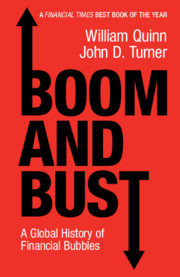Book contents
- Boom and Bust
- Boom and Bust
- Copyright page
- Contents
- Figures
- Tables
- Chapter 1 The Bubble Triangle
- Chapter 2 1720 and the Invention of the Bubble
- Chapter 3 Marketability Revived: The First Emerging Market Bubble
- Chapter 4 Democratising Speculation: The Great Railway Mania
- Chapter 5 Other People’s Money: The Australian Land Boom
- Chapter 6 Wheeler-Dealers: The British Bicycle Mania
- Chapter 7 The Roaring Twenties and the Wall Street Crash
- Chapter 8 Blowing Bubbles for Political Purposes: Japan in the 1980s
- Chapter 9 The Dot-Com Bubble
- Chapter 10 ‘No More Boom and Bust’: The Subprime Bubble
- Chapter 11 Casino Capitalism with Chinese Characteristics
- Chapter 12 Predicting Bubbles
- Acknowledgements
- Notes
- Bibliography
- Index
Chapter 3 - Marketability Revived: The First Emerging Market Bubble
Published online by Cambridge University Press: 06 August 2020
- Boom and Bust
- Boom and Bust
- Copyright page
- Contents
- Figures
- Tables
- Chapter 1 The Bubble Triangle
- Chapter 2 1720 and the Invention of the Bubble
- Chapter 3 Marketability Revived: The First Emerging Market Bubble
- Chapter 4 Democratising Speculation: The Great Railway Mania
- Chapter 5 Other People’s Money: The Australian Land Boom
- Chapter 6 Wheeler-Dealers: The British Bicycle Mania
- Chapter 7 The Roaring Twenties and the Wall Street Crash
- Chapter 8 Blowing Bubbles for Political Purposes: Japan in the 1980s
- Chapter 9 The Dot-Com Bubble
- Chapter 10 ‘No More Boom and Bust’: The Subprime Bubble
- Chapter 11 Casino Capitalism with Chinese Characteristics
- Chapter 12 Predicting Bubbles
- Acknowledgements
- Notes
- Bibliography
- Index
Summary
Chapter 3 examines the bubble that occurred in the UK in 1824 and 1825. This bubble concerned the promotion of Latin American mining companies and various new companies on the London stock market. The price of mining shares quintupled and those of other new companies more than doubled between August 1824 and February 1825. Over the next year, the prices of these stocks plummeted. This was then followed by one of the most serious banking crises ever to hit the UK. The chapter then moves on to discuss how all three sides of the bubble triangle were in play. Marketability had been revived by the liberalising attitudes of MPs in the UK Parliament. Part-paid shares leveraged the buying of shares and, allied to low denominations and low returns on other assets, stimulated speculation. The spark which set the bubble fire alight was a change in government policy towards Latin America and the corporation. The chapter concludes by examining the consequences of the bubble. The post-bubble banking crisis which started in December 1825 resulted in the collapse of many banks and was followed by a very deep recession.
Keywords
- Type
- Chapter
- Information
- Boom and BustA Global History of Financial Bubbles, pp. 39 - 57Publisher: Cambridge University PressPrint publication year: 2020

